April 5, 2023 feature
This article has been reviewed according to Science X's editorial process and policies. Editors have highlighted the following attributes while ensuring the content's credibility:
fact-checked
peer-reviewed publication
trusted source
proofread
Low sulfide concentration in Mercury's smooth plains inhibits geomorphic hollows
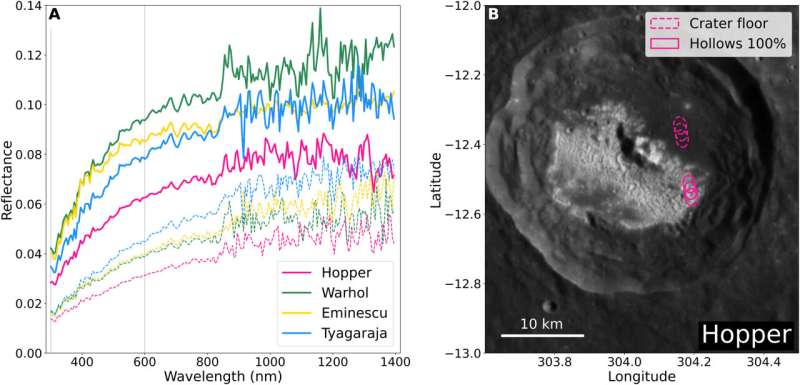
A probe on Mercury used for the purpose of "surface-space-environment-geochemistry-and-ranging" abbreviated as the MESSENGER mission to Mercury, resulted in the discovery of geological structures known as hollows. Such landforms are quintessentially extraterrestrial with no close counterpart on the airless silicate bodies. Astrogeologists had used multispectral images and geochemical measurements via probes to show how hollows formed by the disintegration of volatile-bearing minerals.
In a new report published in Science Advances, Océane Barraud and a research team at the Sorbonne University in Paris and France, and the European Space Astronomy Center Spain, studied the mineralogical composition of hollows by using near ultraviolet to near-infrared spectra obtained from MESSENGER. The team compared the reflectance spectra of hollows by using laboratory spectra of Mercury's analogs. The hollows were enriched with sulfides than those derived from the chemical measurements of Mercury's high-reflectance smooth plains.
Mercury's analogs
During the study, Barraud and colleagues used a Mercury atmospheric and surface composition spectrometer, and visible infrared spectroscopy reflectance spectra of hollows located in the Eminescu, Hopper, Tyagraja and Warhol impact craters. The observations indicated specific materials formation in the structures, alongside a still expanding bright halo. Using thermal modeling, the researchers showed the hollow-forming phase to have been produced through thermal decomposition of sulfides in the low-reflectance material. The research team proposed graphite as a potential component responsible to form the geographical features, while existing work had already shown the presence of sulfur, carbon and chlorine bearing minerals on Mercury.
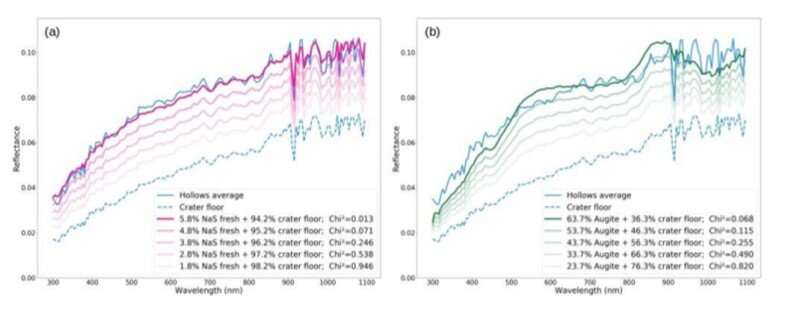
Multispectral data further suggested the presence of magnesium chloride, sodium chloride and calcium chloride as representatives of hollow materials. The team verified each of these hypotheses by comparing geological spectra with laboratory representations of sulfide, graphite, and chloride samples. The research team used a reflectance experiment laboratory catalog to investigate the chemical and physical properties of the samples and compared them with geometrical conditions of laboratory measurements.
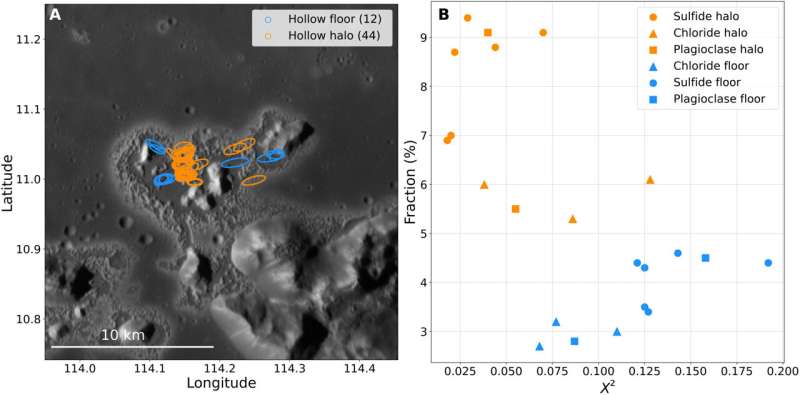
Spectral curvature of the hollows
When the team compared the laboratory spectra, the outcomes did not coincide with values of the hollow spectra derived from MESSENGER imaging probes. They explained these outcomes by the purity, grain size and porosity of laboratory samples that were different on Mercury's surface. Materials forming hollows were not pure compounds, although their unique concave curvature provided a qualitative criterion. The team therefore observed several compounds with concave curvature, which they compared with the hollow spectra. These spectral matches were incomparable however, therefore the researchers used graphite samples with a convex curvature instead.
To perform spectral modeling, the researchers compared laboratory spectra with Mercury's spectra and considered the spectrum of the materials obtained from the floor of the crater as the basis for spectral modeling. The scientists noted a good match between chlorides, although the match level was less than that of sulfides, which incidentally appeared to be the best species to reproduce the curvature of hollow spectra, with a notable match seen with labradorite.
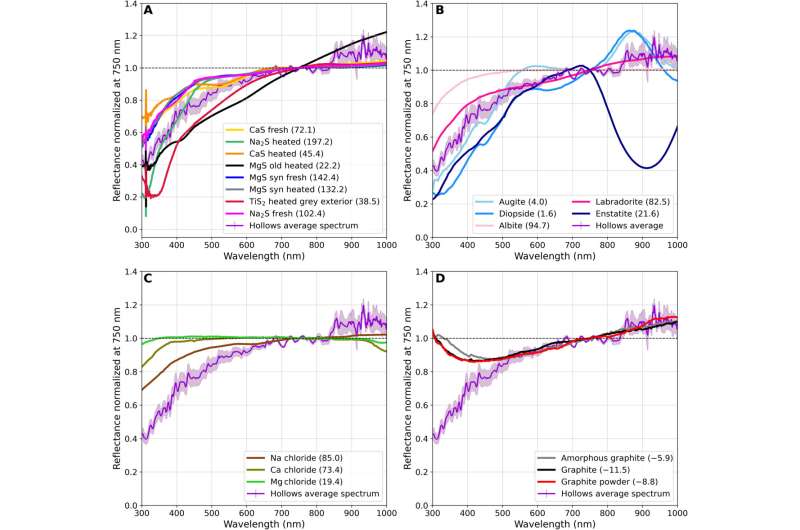
Volatile enrichment within the hollows
Sulfite abundances in the craters decreased when they were mixed with pyroxene or plagioclase (the primary aluminum bimineral and a group of silicates, respectively). For instance, observations within the Eminescu impact crater revealed an average spectrum for the two hollow faces of the floor and of the rim/bright halo. The team explored the best matches within the bright halo for sulfides and chlorides, and found best matches with calcium chloride and magnesium chloride sediments. The match between the surface composition spectra and the modeled spectra was lower in the hollow floor than within the bright halo, indicating that none of the volatile species proposed herein were responsible for the observed outcomes.
Furthermore, the fraction of laboratory spectra derived from spectral modeling were lower in the hollow floor than in the bright halo. The team further resolved 100% of halos using available spectra, but have yet to resolve the floor and halo of hollows studied in this work.
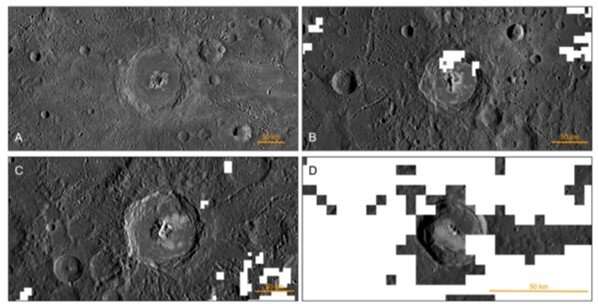
Outlook
In this way, Océane Barraud and colleagues developed a study to examine the sediment minerals and architecture of the floor craters of Mercury known as hollows containing bright halos. The outcomes suggested sulfides to be a material involved in crater formation. The spectra corresponding to the hollows indicated sulfide enrichment, when compared to the host material of the crater floor. The physical mechanisms of the hollow rims and walls detailed the formation of porous and geological forms of developing hollows. The mechanisms described the spectral behaviors across several impact craters on Mercury, including Eminescu, Canova and Tyagaraja. The scientists propose the development of additional chemical reactions to explain the high reflectance of the hollow bright halo via thermal modeling and experimental studies.
The team showed the dynamics of the sulfides at the surface along the hollow rim and floor. The structural diversity in the Eminescu crater suggested the bright halo to be the most enriched facet in sulfur-bearing minerals. The outcomes were consistent with reprecipitation and remobilization of sulfides in the bright halo, as proposed in previous studies. The spectrophotometric properties of the hollows in the craters were consistent with hollow formation. The outcomes showed the dynamic structures to remain intact, when compared to the surrounding materials, to describe their enrichment as a physical, chemical process or a combination of both. The work highlighted spectral and quantitative data for the absence of hollows in high-reflectance smooth plains of Mercury.
More information: Océane Barraud et al, Low sulfide concentration in Mercury's smooth plains inhibits hollows, Science Advances (2023). DOI: 10.1126/sciadv.add6452
Olivier Namur et al, Silicate mineralogy at the surface of Mercury, Nature Geoscience (2016). DOI: 10.1038/ngeo2860
Journal information: Nature Geoscience , Science Advances
© 2023 Science X Network




















